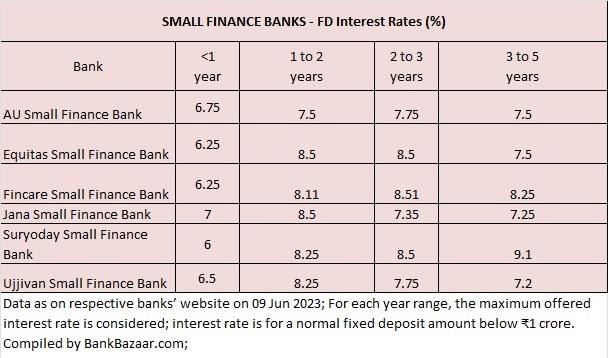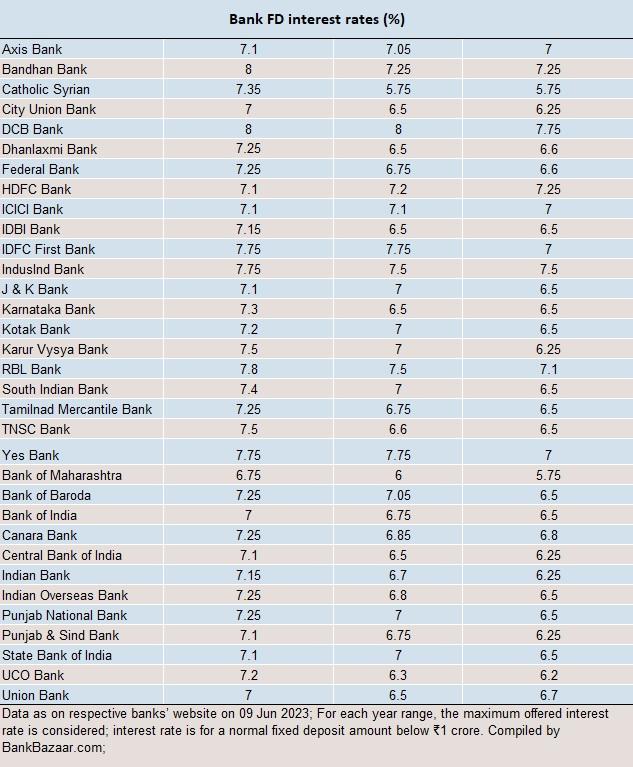Where should you lock your money?
What are fixed deposits?
Also, fixed deposit is taxable unless you are a senior citizen who also gets 0.5% higher returns on your deposits.
The difference between Small finance banks and Commercial Banks and why the former offers higher rates
Mainstream banks generally diversify their lending across sectors and geographies given their national presence. SFBs typically focus on few sectors and could have concentrated operations in few geographies.
“Micro finance lending in Andhra Pradesh had a change in regulation by state government in 2010 which negatively impacted the sector in that state and financial health of institutions. So, investors should evaluate trade off between risk involved and returns generated from investments,” said Thakkar CEO Abans Investment Managers.
Deciding whether to invest in small or big banks for fixed deposits depends on several factors such as the interest rate, safety of your investment, and your personal preferences.
“Get started by reviewing how secure the bank is. Check their records, if they’ve been in the news recently and reviews from other customers on online portals. If you find their record to be squeaky clean you can go ahead and invest,” said Adhil Shetty, CEO of BankBazaar.
Check the credit rating: If you are getting lured by the high interest rate offered by a small savings bank, do check the Crisil rating. Apart from company FDs, this agency awards ratings to bank fixed deposits to indicate how safe they are. FAAA or FAA is the best rating for a fixed deposit whose tenor is greater than a year, whereas for deposits that have a tenor of less than 12 months, the rating you should look for is CRISIL A1+, explained Shetty.
If you are a senior citizen,it is advisable to first exhaust the Senior Citizens’ saving schemes limit with a bank that has a government guarantee before you entrust your money with smaller banks.
In the Budget 2023 recently, Union Finance Minister Nirmala Sitharaman raised the maximum deposit limit for senior citizens from Rs 15 lakh to Rs 30 lakh.Senior citizens’ savings scheme account is a post office savings scheme that can be opened individually or jointly with spouse. An account holder must be above the age of 60 or above 55 so long as s/he has taken a voluntary retirement. Currently, the interest offered on the scheme is 8.2% percent per annum
“Typically, smaller banks offer higher interest rates than larger banks. They need to remain competitive and attract deposits from the market. Today, pretty much every bank offers a rate of 7% or more on select tenors. This is a good time to lock into these tenors. It’s essential to compare these rates. You also need to see if a higher rate is worth the risk,” said Adhil Shetty, CEO of BankBazaar.
Some Small Finance Bank FD rates compared to FD rates of bigger banks


Look for the payout details too:
Different banks may have varying options for interest payout, such as monthly, quarterly, or cumulative interest. Choose a plan and a bank depending on your financial requirement and payout option that suits you best.
Safety of Deposits:
In India, deposits up to Rs 5 lakh (per bank, per depositor) are insured under the Deposit Insurance and Credit Guarantee Corporation (DICGC).
Both small finance banks and public banks fall under this insurance scheme. Check the specific details and ensure that your chosen bank is a member of the DICGC. “”Small finance banks offer 100-200 bps higher interest rates for FDs of similar durations than their larger banking peers. Since the Deposit Insurance and Credit Guarantee Corporation provides deposit insurance of up to Rs 5 lakh per account holder, per bank, including the principal and the interest, investors can safely choose a small finance bank FD to this extent. However, if they want to invest a larger sum, they should engage with multiple small finance banks or even include a few PSB and private banks to contain the risk of a bank failure. They should choose staggered maturity durations to manage the cash flow requirements instead of breaking the FDs,” said Ajinkya Kulkarni, Co-Founder and CEO, Wint Wealth.
In short, manage your exposure to a small finance bank to never exceed Rs 5 lakh. “In case you want a monthly payout, then you may go upto a Rs 5 lakh deposit, and withdraw the interest every month for expenses,” said Chaitali Dutta of Azuke Personal Finance advisory.
Taxation:
Some banks offer tax-saving fixed deposits that qualify for tax deductions under Section 80C of the Income Tax Act. These deposits come with a lock-in period of five years, and the maximum deduction allowed is up to Rs. 1.5 lakh. Ifyou are specifically looking for tax savings along with fixed returns, check if the banks you are considering offer this option. You also need to check that the bank provides the necessary documentation for claiming tax deductions under Section 80C of the Income Tax Act.
Check if the bank issues Form 16A or any other relevant certificates for tax purposes. Your interest income earned from your fixed deposit is taxable under the Income Tax Act, 1961. Both small banks and larger banks follow the same tax rules regarding interest income.
Banks are required to deduct 10% tax at source if the interest income from all bank deposits, including FDs, exceeds Rs. 40,000 in a financial year. However, for senior citizens, this threshold is Rs 50,000. The TDS deducted can be adjusted against your total tax liability while filing your income tax return. “Interest rates on fixed deposits are extremely lucrative with several banks offering interest rate upwards of 7% p.a. and some small finance banks even offering upwards of 8% interest. However, a TDS of 10% is deducted on yearly interest payments over Rs.40,000/- by banking company or co-operative society carrying on banking business and post office. Therefore, to avoid TDS, the investments can be spread across multiple fixed deposits with different maturity dates to keep the interest payments under Rs.40,000,” said Vipul Jai,Partner,PSL Advocates and Solicitors.
Example: If you invested Rs10 lakh in a fixed deposit at 7% per annum, after one year the interest on the FD would be INR 70,000/- which is liable for TDS of INR 7,000/-. However, if the same was spread over two FDs of Rs.5 lakhs each, with interest rate of 7% with maturity date of one year and interest rate of 7.5% with maturity date of two years, you would not be liable to pay any TDS on the interest since the amount interest amounts in both the cases would be less than Rs 40,000.
Services and Convenience:
Consider the convenience and accessibility of services provided by the banks. Large public banks generally have a wide network of branches and ATMs, making it easier to access your funds and manage your fixed deposit. Small finance banks may have a more limited network, which could be a consideration if branch access is important to you.
“Other attributes you may look for is whether the bank is a listed entity (listed entities have higher regulations) whether it has a number of branches in your city (higher the better), will you have access to your account online,” said Dutta.
Customer Service: Evaluate the customer service reputation of the banks. Read reviews, check customer satisfaction ratings, and consider the responsiveness and helpfulness of the bank’s staff.
Who should opt for small finance bank schemes?
“If you’re someone who needs a safe place to keep emergency funds, a retiree who wants a regular interest income from FD, or an investor who just wants to protect their money, then small finance bank deposits might not be the best option for you. However, if you already have investments in other large bank FDs and are willing to take a bit more risk, then SFB deposits can be a good way to do that and optimize your overall FD portfolio returns,” said Dev Ashish, a SEBI-Registered Investment Advisor.
What should your FD strategy be?
” It is better to scatter ur FDs funds investments in such a way that during low bottoming out phase of interest rates, you lock in small amounts in lower fixed rates securities, then in medium term floating rates for more higher allocations and finally when rates peak, higher sums for long term fixed higher rates to optimise your interest income,” said Adarsh Saxena, CA and financial consultant.
 Loan, Personal Loan, Home Loan, Business Loan,Loans in India Loan in India, Personal Loan, Home Loan, Business Loan, Loans in India,Loan Finance,Loan in India, Get Instant Personal Loan,Home Loan, Business Loans in India
Loan, Personal Loan, Home Loan, Business Loan,Loans in India Loan in India, Personal Loan, Home Loan, Business Loan, Loans in India,Loan Finance,Loan in India, Get Instant Personal Loan,Home Loan, Business Loans in India